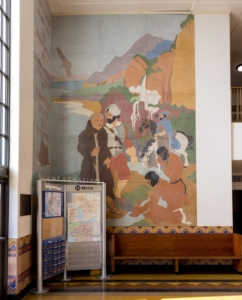News
Update on City Council’s May 11th Decision to Cover Up the City Hall Murals
by Ruthann Lehrer, Advocacy Committee Co-Chair
The interior public lobby of City Hall as well as its architecture are protected historic resources designated in 1979, and the Stanton MacDonald-Wright murals are specifically identified as important features. The Municipal Code defines the process to be followed if alterations are proposed. The Santa Monica Landmarks Ordinance clearly indicates that the Landmarks Commission must review this alteration under the Certificate of Appropriateness provisions.
Such protections are fundamental to the entire program for the survival of designated historic resources, and those located at the heart of our civic government are the most obvious examples. The Santa Monica Conservancy, with the advice of our attorney, has communicated this message to the City Manager, City Attorney and City staff in a letter, and we are awaiting a response. (See our previous advocacy efforts here.)
If this process is followed, the Landmarks Commission would conduct a public hearing on this application, as it has for other applications affecting City Hall, such as the new Annex, remodeled entryway and Ken Genser Square. In addition to public testimony, the expertise of the Landmarks Commission could provide guidance about understanding and interpreting the murals’ imagery and themes.
Because the image of the the sacred Kuruvungna Springs is so critical to understanding the History mural, we reached out to the Gabrielino Tongva Springs Foundation, the Native American group that restored the sacred waters at University High School and preserves them as essential to its history.
The History mural in City Hall depicts the first contact between Europeans and Native Tongva at the springs, and the naming of Santa Monica. Gabrielino Tongva Springs Foundation members seem keenly interested in preserving their history as depicted at Santa Monica City Hall. The Foundation also recently re-opened the Kuruvungna Springs to the public on the first Saturday of the month; access is from Barrington Avenue south of Texas Avenue.
Members of the founding families of Santa Monica have also reached out to us, concerned about the eradication of their histories. Descendants of the Marquez and Reyes families from Rancho Boca de Santa Monica as well as the Bandini family find their stories referenced in the mural that will be removed from public view. Indeed, the name Ysidro Reyes is actually inscribed in the mural.
Companion to the History mural is one showing Recreation, depicting popular spectator sports — polo, tennis, auto races, aviation and sailing — that attracted visitors to the City. While these images seem elitist today, these recreational activities helped boost the City as a tourist destination.
Discussions about the murals’ future have affirmed that there is strong interest in a robust public discussion and debate about their historic context, their explicit and implicit meanings, and how we can educate our community about social justice. An interpretive explanation or exhibit is crucial for the murals as the touchstone for understanding the past and discussing issues of social equity and inclusion. But covering the murals does not advance that goal. At this intersection of history, public art and social justice, the Santa Monica Conservancy believes we have an opportunity to create public engagement and educate our community about our past and the value of preservation, and promote social equity.
This entry was posted in City Hall Mural.
Bookmark the permalink.
